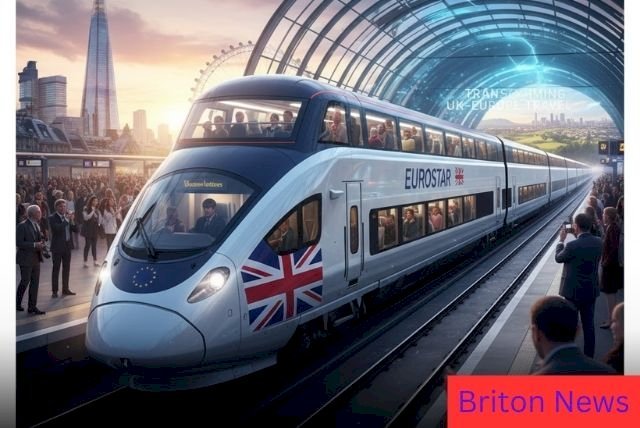Double-Decker Trains to Transform London’s Eurostar Services: A New Era for UK–Europe Travel (2025 Update)
Eurostar invests €2 billion in the UK’s first double-decker Celestia trains. Discover how these new high-speed trains will boost capacity, cut emissions, and transform travel between London and Europe by 2031.

In a landmark announcement for the UK rail industry, Eurostar has confirmed a €2 billion (£1.74 billion) investment in its first-ever double-decker trains, marking the most significant fleet upgrade since services began through the Channel Tunnel in 1994.
The new Eurostar Celestia fleet will introduce double-decker high-speed trains to the UK for the first time, transforming cross-Channel travel between London, Paris, Brussels, and Amsterdam. The move aims to increase passenger capacity, cut emissions, and enhance sustainability in line with Europe’s long-term green transport strategy.
Details of the New Trains
Built by Alstom, the new Celestia double-decker trains are based on the manufacturer’s Avelia Horizon (TGV M) platform. Each train features two passenger decks, improved aerodynamics, and lighter materials for enhanced energy efficiency.
Key specifications include:
-
Two levels of seating with panoramic upper-deck windows.
-
Around 540 seats per train, approximately 20% more than the existing Siemens e320 single-decker trains, which seat about 450–500 passengers depending on configuration.
-
Enhanced digital connectivity, wider aisles, and expanded luggage capacity.
-
Designed to operate at speeds of up to 320 km/h (200 mph) on existing high-speed lines.
The double-decker design provides significantly greater capacity without requiring additional tunnel slots, making it a smarter way to increase ridership through the Channel Tunnel — which has a height restriction of approximately 4.28 metres, one of the key reasons bi-level trains have been rare in the UK.
Investment and Manufacturing
The €2 billion order covers 30 double-decker Celestia units, with an option for 20 more as passenger demand continues to rise.
Production will take place at Alstom’s sites in France and Belgium, while maintenance operations will be supported by Eurostar’s depots in London and Kent, ensuring UK-based engineering employment.
This investment supports Eurostar’s post-merger growth (after its integration with Thalys in 2023) and underlines its commitment to sustainable expansion and passenger experience improvements across Europe.
Jean-Marc Groleau, Eurostar’s Operations Director, said:
“This next-generation fleet represents a bold step forward for sustainable European travel. It will enable us to carry more passengers efficiently, with lower emissions and greater comfort.”
Impact on Passengers
Passengers can expect a new level of comfort and efficiency once the Celestia fleet enters service.
Highlights include:
-
20% more seating capacity, reducing pressure on ticket availability during peak travel periods.
-
Larger windows offering better upper-deck views of the European countryside.
-
Improved seating ergonomics, noise insulation, and digital connectivity.
-
Upgraded Wi-Fi, USB-C charging points, and lighting systems for modern travellers.
The increased seating and energy efficiency could help stabilise or reduce ticket prices, while the quieter cabins and smoother ride will enhance the overall journey experience.
Environmental and Sustainability Aspects
Sustainability is central to Eurostar’s new fleet investment.
According to Alstom, the Celestia double-decker trains will be up to 50% more energy-efficient than the current generation, thanks to improved aerodynamics, regenerative braking, and lightweight construction.
Eurostar has pledged to reduce its carbon footprint per passenger by 30% by 2030.
This goal is part of Eurostar’s company-wide sustainability strategy, complementing — but distinct from — broader UK and EU net-zero transport targets.
Rail travel already emits up to 95% less CO₂ per passenger than flying between London and Paris. The Celestia fleet will further enhance that advantage, reinforcing Eurostar’s position as one of Europe’s most environmentally responsible transport operators.
Future Timeline and Implementation
The first Celestia trains are expected to enter service by 2031, pending full regulatory approval.
This timeline includes certification by the UK Rail Safety and Standards Board (RSSB), the European Union Agency for Railways, and Getlink, the Channel Tunnel’s infrastructure operator.
Infrastructure upgrades are planned for London St Pancras International, Paris Gare du Nord, and Brussels Midi to accommodate increased passenger volumes and boarding access to upper decks.
Initial deployment will focus on the core Eurostar routes:
-
London–Paris
-
London–Brussels
-
London–Amsterdam
Future expansion is planned to Cologne and other European cities, supporting Eurostar’s growth ambitions into the 2030s.
Context and Industry Significance
This announcement marks a historic moment for the UK railway system.
Double-decker high-speed trains have long been common in Europe — notably the TGV Duplex in France — but have never operated in the UK due to tunnel and platform constraints.
The introduction of the Celestia fleet represents technological adaptation and cross-border cooperation, as engineers have found ways to maintain the required Channel Tunnel safety clearance (4.28m) while adding an upper level of seating.
For Eurostar, this is more than a fleet upgrade; it’s a strategic move to double capacity and respond to a new era of sustainable travel demand.
It also positions Eurostar to compete more effectively with low-cost airlines on short-haul European routes.
Challenges and Considerations
Eurostar’s project faces a few challenges before the 2031 rollout:
-
Height and safety certification under Channel Tunnel regulations.
-
Station compatibility — ensuring boarding and evacuation systems are seamless for two-deck operations.
-
Border and security management, particularly with increased passenger loads post-Brexit.
-
Maintenance adaptation for more complex double-deck rolling stock.
Industry experts note that while the design is ambitious, early coordination with regulators and Alstom’s proven TGV M platform will help smooth the certification process.
Conclusion
Eurostar’s introduction of double-decker Celestia trains marks a new era in UK–Europe connectivity.
By combining increased capacity, enhanced passenger experience, and major energy savings, this €2 billion investment positions Eurostar at the forefront of sustainable rail innovation.
When the first trains enter service — expected by 2031, pending final approval — passengers travelling from London to Paris or Brussels will experience a new standard of high-speed comfort aboard the UK’s first-ever bi-level trains.
This development not only transforms Eurostar’s future but also symbolises a broader shift toward greener, high-capacity transport across Europe.
Read Also:
Jaguar Land Rover Cyberattack 2025: HELLCAT Ransomware Shuts Down UK Production
FAQs About Eurostar’s New Double-Decker Trains (2025)
1. What are Eurostar’s new double-decker trains?
Eurostar’s new double-decker Celestia trains are next-generation high-speed trains designed by Alstom. They will operate between London and major European cities such as Paris, Brussels, and Amsterdam. These trains will have two passenger decks, offering around 540 seats, about 20% more than current Eurostar trains, and improved energy efficiency.
2. When will Eurostar’s double-decker trains start service?
The first Eurostar double-decker trains are expected to enter service by 2031, subject to approval from the UK Rail Safety and Standards Board (RSSB), European regulators, and Getlink, which manages the Channel Tunnel.
3. Who is building Eurostar’s double-decker trains?
The trains are being built by Alstom, one of Europe’s leading train manufacturers. They will be based on Alstom’s Avelia Horizon (TGV M) platform, the same design used for France’s new high-speed TGV trains. Production will take place in France and Belgium, with maintenance support in London and Kent.
4. How much is Eurostar investing in the new trains?
Eurostar has committed €2 billion (£1.74 billion) for an initial order of 30 double-decker Celestia trains, with an option for 20 more in the future. It is one of the largest train investments in Eurostar’s history.
5. How many passengers will the new Eurostar double-decker trains carry?
Each Celestia double-decker train will carry around 540 passengers, about 20% more than the current Siemens e320 single-deck models, which seat between 450 and 500 passengers depending on configuration.
6. Why has Eurostar decided to use double-decker trains?
Eurostar’s decision aims to increase capacity, improve sustainability, and reduce emissions. The Channel Tunnel has a limited number of train slots, so using double-decker trains allows Eurostar to carry more passengers per journey without adding more departures.
7. What routes will Eurostar’s double-decker trains operate on?
The new trains will first operate on Eurostar’s core routes — London to Paris, London to Brussels, and London to Amsterdam. Over time, they may also extend to Cologne and other European destinations as Eurostar expands its network.
8. How tall is the Channel Tunnel, and how do double-decker trains fit?
The Channel Tunnel has a height restriction of about 4.28 metres, which has historically limited train design. The new Celestia trains are specifically engineered to fit within this clearance while providing two passenger levels safely and comfortably.
9. How energy-efficient are the new Eurostar double-decker trains?
The Celestia fleet is expected to be up to 50% more energy-efficient than Eurostar’s current models. This efficiency comes from lightweight construction, improved aerodynamics, and regenerative braking technology that recovers and reuses energy during travel.
10. What is Eurostar’s carbon reduction goal with these trains?
Eurostar aims to reduce carbon emissions per passenger by 30% by 2030, as part of its company-wide sustainability strategy. The introduction of double-decker trains plays a major role in achieving this target, alongside ongoing renewable energy and electrification efforts.
11. Will ticket prices change when the double-decker trains launch?
Eurostar expects that increased seating capacity will help stabilise ticket prices and make more seats available during peak travel periods. While premium seating and amenities will remain, more standard-class tickets could help make travel more affordable overall.
12. What new features will passengers find on the Celestia trains?
Passengers can expect modern interiors, better Wi-Fi, USB-C charging, quiet cabins, and larger windows with scenic upper-deck views. The new design focuses on comfort, accessibility, and sustainability for both leisure and business travellers.
13. How do these trains support Eurostar’s sustainability goals?
The Celestia trains consume less electricity, produce fewer emissions, and allow more passengers per journey, making each trip more carbon-efficient. This supports both Eurostar’s 2030 sustainability targets and the EU’s broader net-zero transport goals.
14. Are double-decker trains common in the UK?
No, double-decker trains are unprecedented in UK high-speed rail. They are widely used in Europe — especially in France’s TGV Duplex fleet — but this will be the first time bi-level trains operate in the UK, adapted to the Channel Tunnel’s height and safety standards.
15. What challenges must Eurostar overcome before launch?
Eurostar must complete safety testing, station upgrades, and regulatory certification before launching the double-decker trains. Adjustments at London St Pancras International and Paris Gare du Nord will ensure accessibility and passenger flow for the two-level design.
















